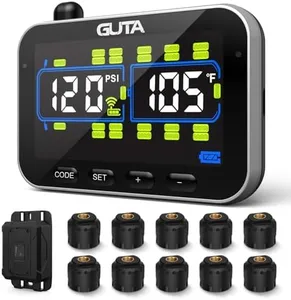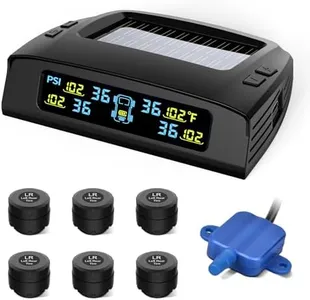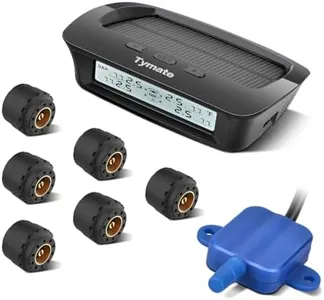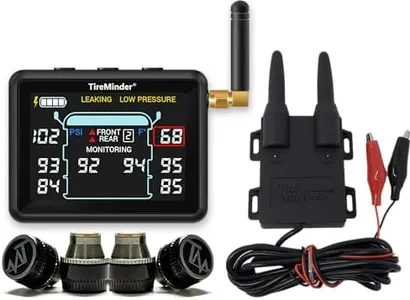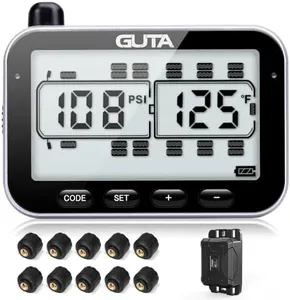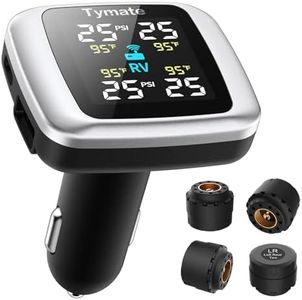We Use CookiesWe use cookies to enhance the security, performance,
functionality and for analytical and promotional activities. By continuing to browse this site you
are agreeing to our privacy policy
10 Best Tire Pressure Monitoring Systems 2025 in the United States
How do we rank products for you?
Our technology thoroughly searches through the online shopping world, reviewing hundreds of sites. We then process and analyze this information, updating in real-time to bring you the latest top-rated products. This way, you always get the best and most current options available.

Buying Guide for the Best Tire Pressure Monitoring Systems
Choosing the right tire pressure monitoring system (TPMS) is crucial for maintaining the safety and efficiency of your vehicle. A TPMS helps you keep track of the air pressure in your tires, ensuring they are properly inflated. This can prevent accidents, improve fuel efficiency, and extend the life of your tires. When selecting a TPMS, consider the following key specifications to find the best fit for your needs.Type of TPMSThere are two main types of TPMS: direct and indirect. Direct TPMS uses sensors mounted inside the tires to measure air pressure and send real-time data to your vehicle's onboard computer. Indirect TPMS, on the other hand, estimates tire pressure based on wheel speed and other data. Direct TPMS is generally more accurate and reliable, making it a better choice for those who prioritize precision. Indirect TPMS can be less expensive and easier to install but may not provide as accurate readings. Choose direct TPMS if you want precise monitoring and indirect TPMS if you prefer a simpler, more cost-effective solution.
Sensor Battery LifeSensor battery life is an important consideration because it determines how often you will need to replace the sensors. Most TPMS sensors have a battery life ranging from 5 to 10 years. Longer battery life means less frequent replacements and lower maintenance costs. If you drive frequently or over long distances, opt for sensors with a longer battery life to avoid the hassle of frequent replacements. For occasional drivers, a shorter battery life may be sufficient.
Display TypeThe display type of a TPMS can vary, with some systems using a dedicated display unit while others integrate with your vehicle's existing dashboard display. Dedicated display units can be mounted on your dashboard or windshield, providing a clear and constant view of tire pressure. Integrated displays offer a more seamless look and may be easier to use if you prefer fewer gadgets in your car. Choose a display type based on your preference for visibility and integration with your vehicle's interior.
Alert SystemThe alert system of a TPMS notifies you when tire pressure is outside the recommended range. Alerts can be visual, auditory, or both. Visual alerts typically appear as warning lights or messages on the display, while auditory alerts are beeps or chimes. Some systems also offer smartphone notifications. Consider how you prefer to be alerted and choose a system that matches your preference. If you often drive in noisy environments, a visual alert may be more effective, while auditory alerts can be helpful if you want immediate attention.
Ease of InstallationEase of installation is an important factor, especially if you plan to install the TPMS yourself. Some systems are designed for easy DIY installation, with sensors that can be screwed onto the valve stems of your tires. Others may require professional installation, particularly if they involve internal sensors. If you are comfortable with basic car maintenance tasks, a DIY-friendly system can save you time and money. If not, consider a system that includes professional installation or is known for its ease of setup.
CompatibilityCompatibility refers to whether the TPMS is suitable for your specific vehicle make and model. Some TPMS are universal and can be used with any vehicle, while others are designed for specific brands or types of vehicles. Ensure that the TPMS you choose is compatible with your vehicle to avoid any installation issues or inaccurate readings. Check the manufacturer's specifications and, if in doubt, consult with a professional to confirm compatibility.
Most Popular Categories Right Now





